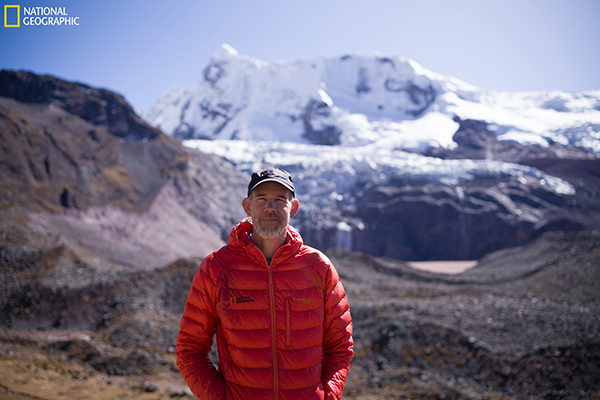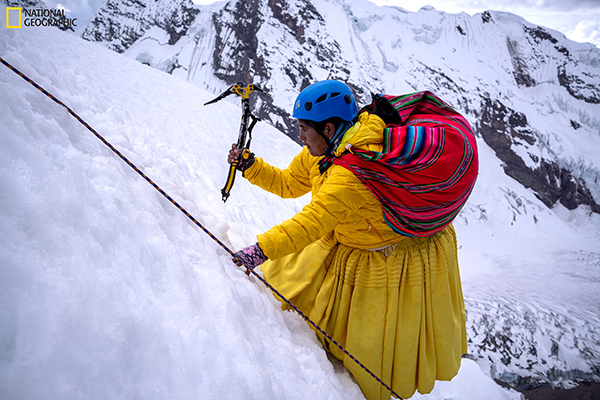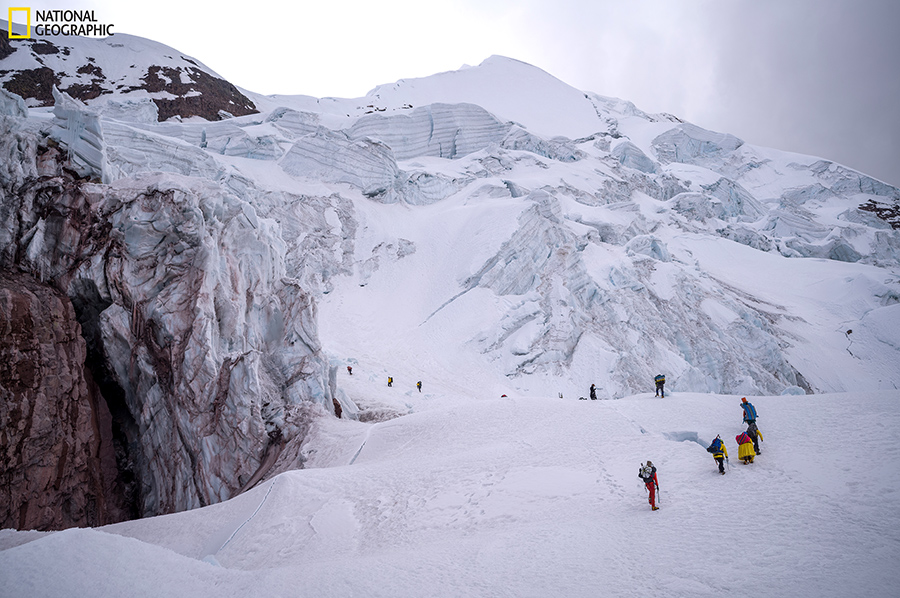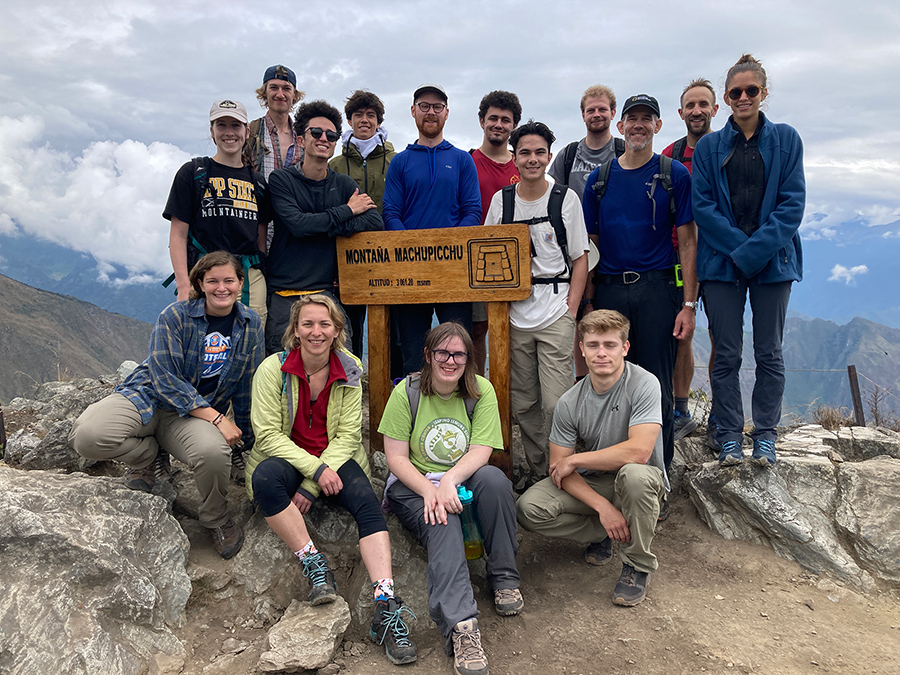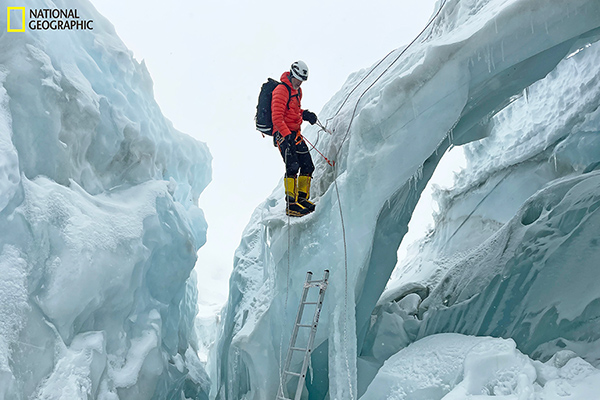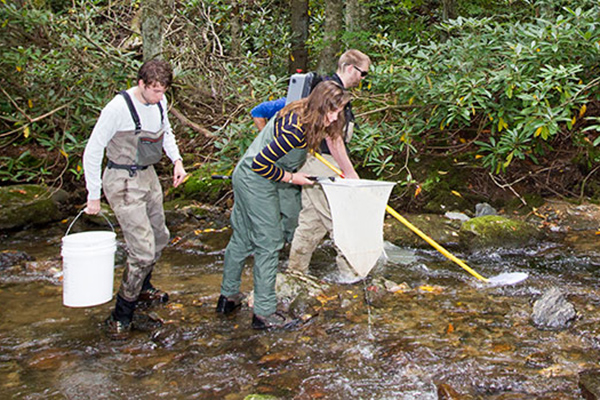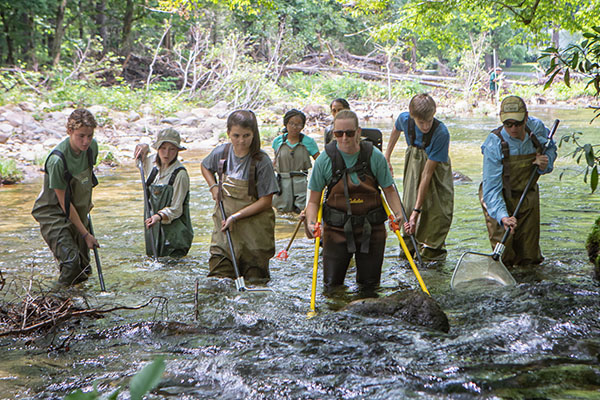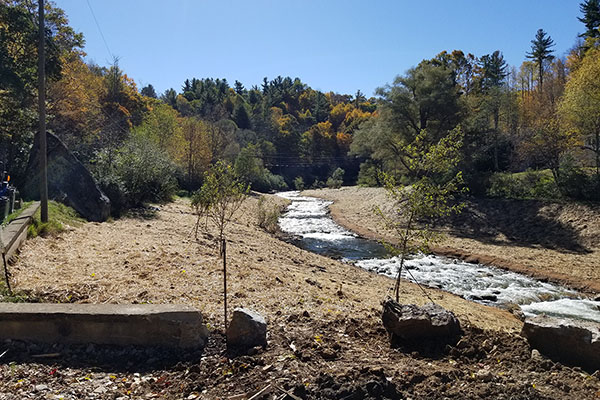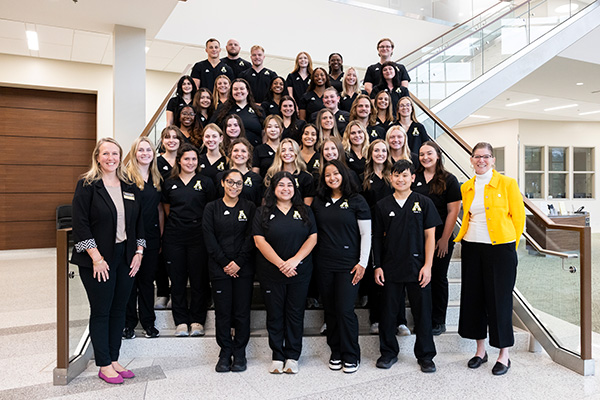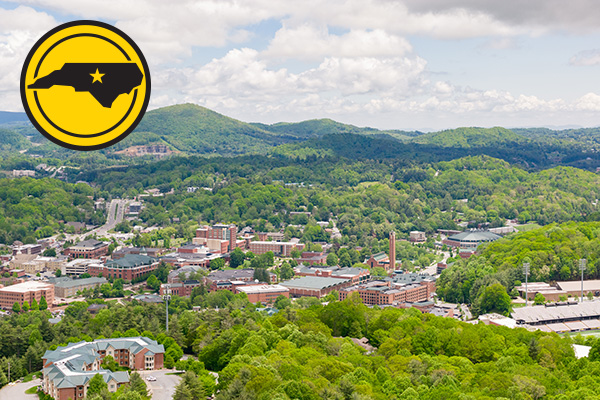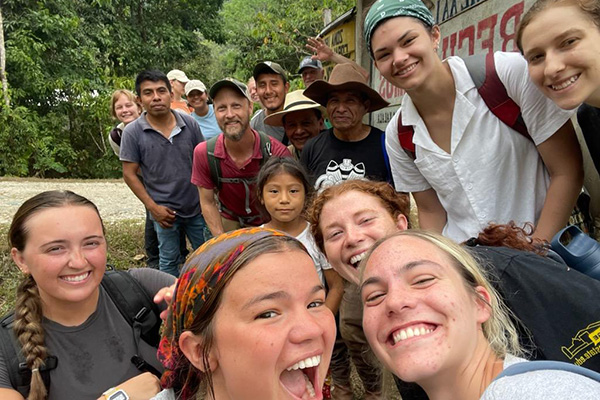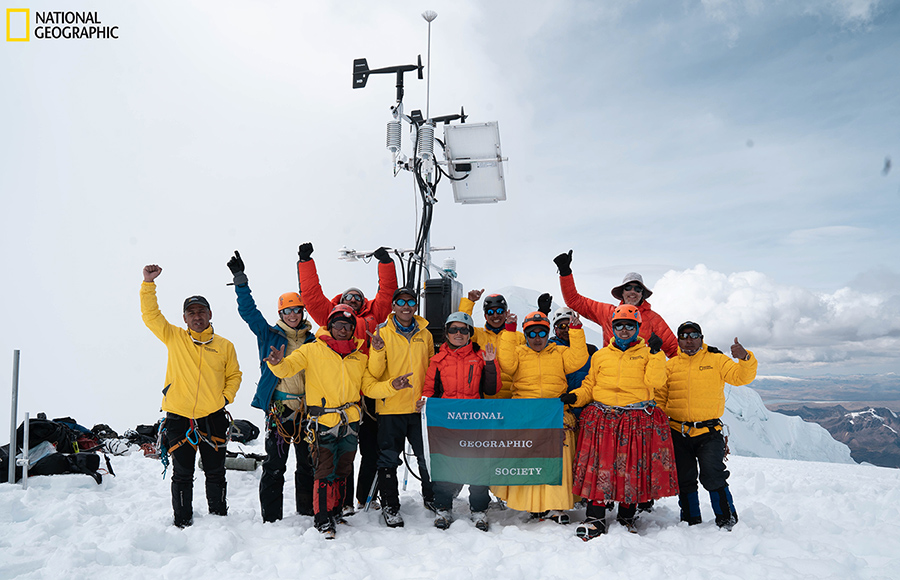
The National Geographic Society team celebrates the successful installation of the highest weather station in the Andes, near the peak of Nevado Ausangate. Dr. Baker Perry, National Geographic Explorer and professor in App State’s Department of Geography and Planning, pictured at far right in the back row, co-led the expedition along with Dr. Tom Matthews, pictured third from left in the back row. App State alumna Heather Guy ’18, second from left, was a member of the expedition team. A local Peruvian Quechua team and the Cholitas Escaladoras — female Bolivian climbing experts — supported the expedition team and served as climbing guides. Photo by Justen Bruns/National Geographic
BOONE, N.C. — A dozen Appalachian State University students investigated the impacts of climate change in the Andes during a study abroad program this summer in Peru — and accompanied a National Geographic Society (The Society) team during the acclimatization and preparation for installing the highest weather station in the tropical Andes, near the peak of Nevado Ausangate.
Dr. Baker Perry, National Geographic Explorer and professor in App State’s Department of Geography and Planning, led the study abroad program Peru: Climate Change in the Andes from July 6–22. Then, he led The Society expedition team to install the weather station, sample microplastics and water isotopes in the summit snowpack and make other atmospheric and glaciological observations.
The July 25 weather station installation was a significant milestone in the 2022 National Geographic and Rolex Perpetual Planet Amazon Expedition, a two-year exploration of the Amazon River Basin spanning the Andes to the Atlantic.
“Nevado Ausangate is one of the most critical mountains in the high Andes as it serves as the primary freshwater source for Andean and downstream ecosystems,” said Perry.
The new weather station, installed just below the summit at 20,830 feet (6,349 meters), collects meteorological data such as temperature, precipitation, humidity, radiation and snow depth, all of which will aid local governments and the international scientific community in observing the impacts of climate change on critical water resources that affect local communities.
“It is essential that we use weather observations from the highest peaks in the world to better understand the impacts that climate change is having on local and global communities. The changes happening on Ausangate are especially important in understanding the fluctuations and adaptations of the entire Amazon River watershed,” Perry added.
App State alumna Heather Guy ’18, who is pursuing her Ph.D. at the University of Leeds in West Yorkshire, England, was another member of the expedition team. Guy — who has been working as a science technician at Summit Station in Greenland — and National Geographic Explorer and expedition co-leader Dr. Tom Matthews assisted Perry during the study abroad program as well.
Perry, Matthews and Guy will analyze data from the Ausangate station, in cooperation with the National University of Saint Anthony the Abad in Cuzco (UNSAAC), the Higher University of San Andrés (UMSA) in Bolivia and the National Meteorology and Hydrology Service of Peru — all partners in the expedition.
Perry said he incorporates all of his experiences as a National Geographic Explorer directly into the classroom at App State — both in lectures and in laboratory assignments — in his Global Climate Change course. “I anticipate our students will assist with the data analysis from the weather stations,” he shared.
Guy, who served as Perry’s research assistant in 2018 while earning her Master of Arts in geography at App State, said learning about Perry’s cutting-edge research helps students understand the relevance of their studies beyond classrooms and exams.
“By being involved in the research project through the study abroad experience, the students learn firsthand that it is not only academic knowledge that makes scientific research successful. Skills such as leadership, perseverance, observation and cultural sensitivity are also vital,” Guy said.
The new Ausangate station builds upon previous Perpetual Planet Expeditions to install weather stations in high mountain environments, including to the Tupungato volcano in Chile in 2021 as well as to Mount Everest in 2019 and 2022, all of which included Perry. Rolex supports these expeditions as part of its Perpetual Planet initiative.
Nicole Alexiev, vice president of science and innovation programs at The Society, said the goal of the work in the Amazon River Basin is to “illuminate the critically important role this region plays in stabilizing the health of the planet, to support scientific fieldwork to better understand how climate change and other environmental factors are affecting the region and, importantly, to invest in solutions to ensure its protection.”
The initiative combines photojournalism, scientific fieldwork and partnering with local communities to highlight the effects of climate and environmental change — and the people who are working to find solutions.
Study abroad, plus a bonus
During his time at App State, Perry has led 19 study abroad education and research expeditions to the Andes, with the opportunity for students to learn about climate change, glaciers, water resources and the local culture. Perry and local collaborators operate a weather station on the Quelccaya Ice Cap (elevation of 18,537 feet, or 5,650 meters) and students hike to the station to help maintain the station and gather ice samples.
The high elevation of the summit of the glacierized area — and the intensive climb to reach it — requires gradual acclimatization over several days, in order to minimize risk of altitude sickness. The Society’s expedition team accompanied the App State students during this summer’s study abroad program in order to acclimatize for their climb up Ausangate.
The students were able to interact with The Society’s expedition team’s climate scientists and media professionals. “It added so much to the students’ experience,” Perry said.
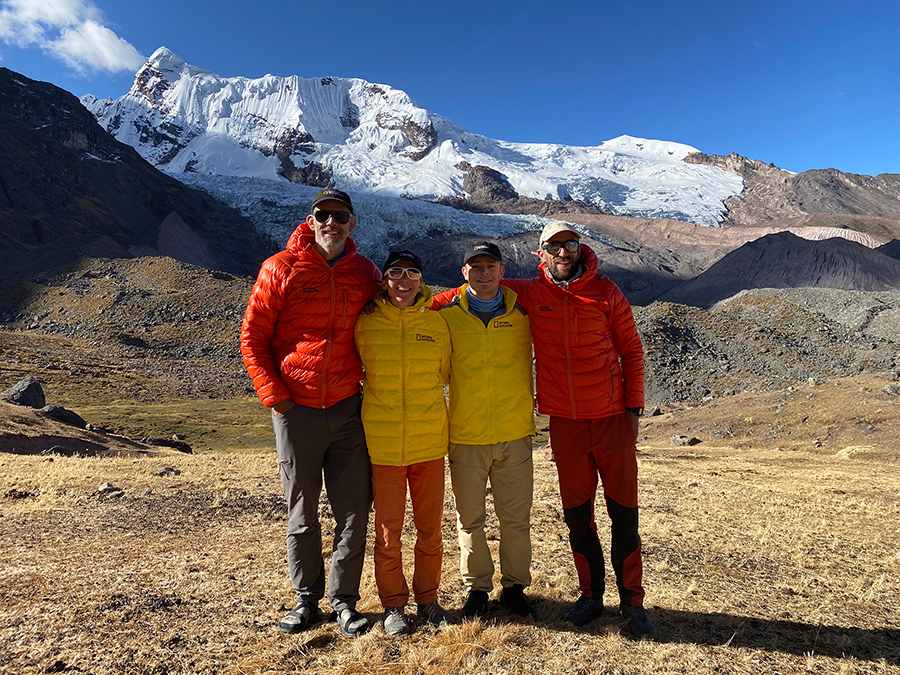
Alex Moore, an App State junior from Watkinsville, Georgia, attended the university’s Peru: Climate Change in the Andes study abroad program in July. Moore, pictured second from right, extended his trip to assist Dr. Baker Perry, National Geographic Explorer and professor in App State’s Department of Geography and Planning, and the rest of the National Geographic Society expedition team on their expedition to install a weather station on top of Ausangate. Also pictured, from left to right, are Perry, App State alumna Heather Guy ’18 and Dr. Tom Matthews, all members of the expedition team. Photo submitted by Baker Perry
Alex Moore, an App State junior from Watkinsville, Georgia, who is majoring in biology-ecology, evolution and environmental biology, attended the study abroad program and extended his trip to assist with the Ausangate expedition.
Moore said he could “write a book” about all he learned concerning the culture of Peru, different scientific disciplines and working in high altitudes.
Prior to his time in Peru, Moore said it was difficult for him to imagine what climate change and its impact look like.
“It hits you like a train when you see pictures from 10 years ago versus what you are seeing right in front of you,” Moore said. “Walking up to a glacier early in the morning that, by afternoon, becomes a stream of water and slush makes an impression in the worst way possible.”
During the Ausangate expedition, Moore assisted the media crew, carried sections of the weather station to the base of the glacier and labeled ice samples. Though he did not climb to the summit with the team to assemble the weather station, Perry said Moore was a “huge help,” particularly when one member of the media team had to return to Cusco with sickness prior to the completion of the expedition.
From the film crew, to the researchers, to the climbing guides, Moore said he was exposed to people who were at the “top of their game” and valued the opportunity to learn from them. After his experience, Moore said he would like to pursue a career in climate studies.
What do you think?
Share your feedback on this story.
About the Department of Geography and Planning
The Department of Geography and Planning promotes the understanding of the spatial dimensions of human behavior within the physical and cultural systems of the earth, and the role of planning in achieving improvement in those systems. The department offers degrees in geography and in community and regional planning. Learn more at https://geo.appstate.edu.
About the College of Arts and Sciences
The College of Arts and Sciences (CAS) at Appalachian State University is home to 17 academic departments, two centers and one residential college. These units span the humanities and the social, mathematical and natural sciences. CAS aims to develop a distinctive identity built upon our university's strengths, traditions and locations. The college’s values lie not only in service to the university and local community, but through inspiring, training, educating and sustaining the development of its students as global citizens. More than 6,800 student majors are enrolled in the college. As the college is also largely responsible for implementing App State’s general education curriculum, it is heavily involved in the education of all students at the university, including those pursuing majors in other colleges. Learn more at https://cas.appstate.edu.
About Appalachian State University
As a premier public institution, Appalachian State University prepares students to lead purposeful lives. App State is one of 17 campuses in the University of North Carolina System, with a national reputation for innovative teaching and opening access to a high-quality, cost-effective education. The university enrolls more than 21,000 students, has a low student-to-faculty ratio and offers more than 150 undergraduate and 80 graduate majors at its Boone and Hickory campuses and through App State Online. Learn more at https://www.appstate.edu.
